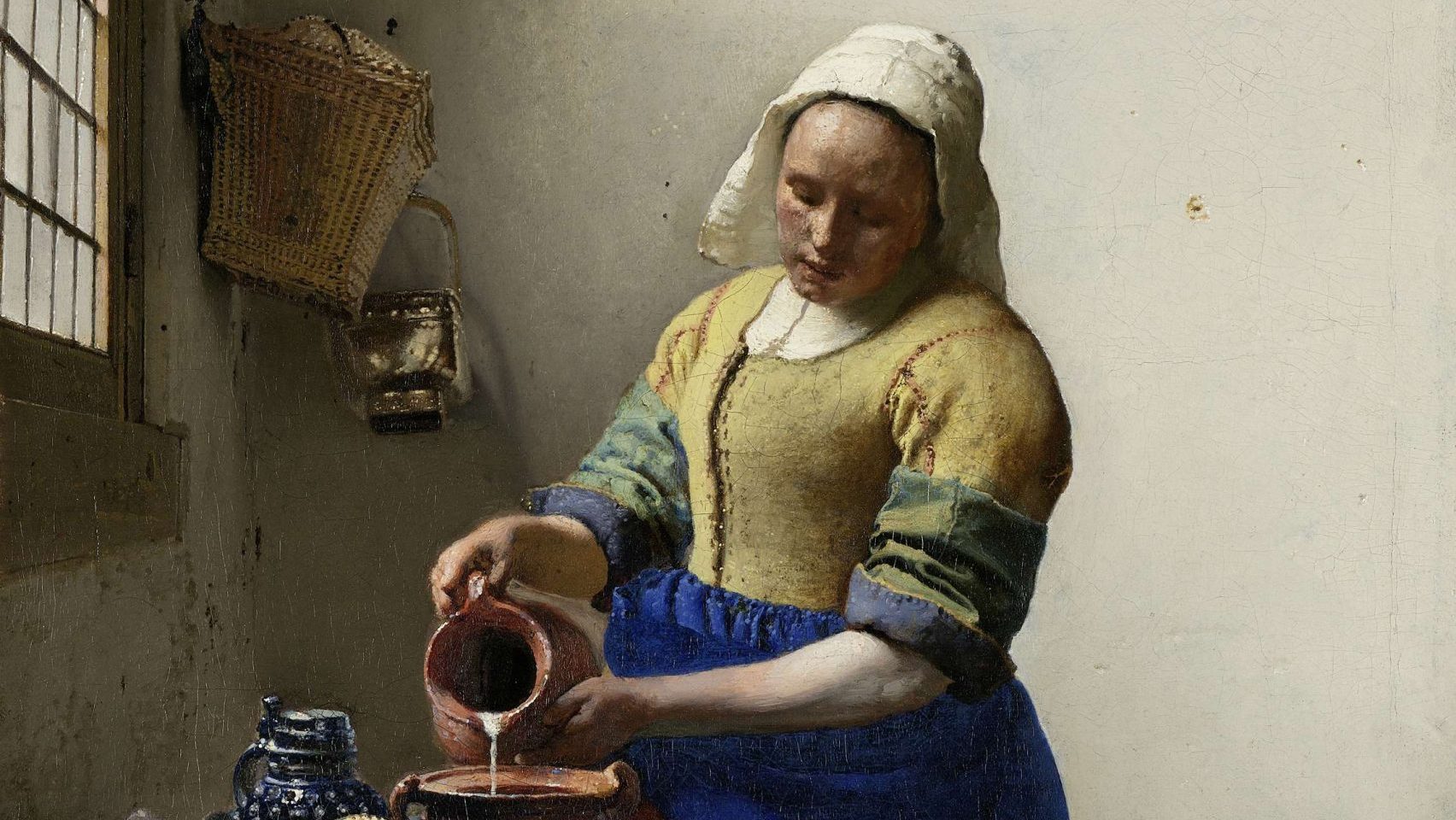At first glance, it is an ordinary woman performing an everyday chore. She
pours milk from a jug, working near the window for daylight on her mealtime task, sleeves pushed up, lips parted in concentration, bread and
fruit at the ready. But as painted by Johannes Vermeer, The Milkmaid (1658-59) is elevated to monumental status, and she is the object of art lovers’ veneration in her current home, the Rijksmuseum in Amsterdam.
There she is normally on display in the Gallery of Honour, alongside Woman in Blue Reading a Letter (1662-64) and View of Houses in Delft (1658-59), known as The Little Street. But in an exhibition without precedent – and surely without equal in the future – these three works are joined, for the most part until June 4, by no fewer than 25 others by Vermeer, loaned by galleries from all around the world.
It is a remarkable haul, given that there are only 37 known Vermeers out
of about 50 thought to have been painted during the artist’s 20-year
career. The rest are lost, including one stolen in 1990: The Concert, formerly in the Isabella Stewart Gardner gallery in Boston, and possibly held as collateral by criminals, the ultimate Get Out of Jail Free card.
But even without the silenced song of The Concert, music rings out of this
exceptional gathering of paintings. This is not so much a family reunion –
for the works would not have been under the same roof at the same time
in the artist’s lifetime – it is more an art lover’s over-optimistic dream made
reality. To swivel from this lutenist to that player of the virginals, or from
this letter-reader to that correspondent writing her reply, is an unimagined luxury.
Luxury is not a word we associate with the relatively austere interiors of 17th-century Netherlands, poorly lit except by the sun, hard-floored, heavily but sparsely furnished. Vermeer enriched his domestic scenes, however, with props whose repeated use pulsates through the rooms. Here is a fur-trimmed yellow satin jacket – and here, and here again, appearing in step together from New York, Washington and Berlin. There is a favourite chair with its lion-head finials. It appears in two works dated between 1664 and 1667, and owned by the National Gallery of Art, Washington: Girl with a Red Hat and Girl with a Flute, the latter sometimes disputed as the work of Vermeer.
We know from the inventory of household goods listed after his death,
at the age of 43, that the artist owned this jacket, and other chairs in vogue,
upholstered in highly decorative tapestry, and often depicted. Debilitated by his country’s year of military and economic disaster, its Rampjaar, in 1672, and by sluggish sales, Vermeer died suddenly in 1675, leaving his widow, Catharina, to support the 11 surviving children of the couple’s 14 offspring.
Three palettes, and the two easels on which he painted what are, today, among the world’s most valuable paintings, went up for sale. So did six
panels and 10 canvases, supports for Vermeer paintings that never materialised. The artist’s reputation withered, and it was not until the mid-19th century that his stock rose again.
But at his birth in 1632, Vermeer was in the right place at the right time. In the early 17th century Delft, just south of The Hague, was becoming a magnet for artists, collectors and dealers. Even young Johannes’s father,
Reynier Janszoon, innkeeper at De Vliegende Vos (The Flying Fox) dealt
in artworks, too. Delft derives its names from the Dutch for digging, and the narrow streets alongside the criss-crossing canals were lined with businesses that thrived on this craze among the “art thirsty” – the const-dorstich. There was, in the sharp, bright air over the waterways, a sort of art mania to rival the mania for tulips.
But while bulbs were ultimately madly priced and perishable, the works of art that were changing hands can today be seen in galleries worldwide. Leading artists of the day worked round the corner from Vermeer’s childhood home, among them Pieter de Hooch, Jan Steen and Rembrandt’s notable pupil Carel Fabritius. One local collector, a notary, scooped up a Rembrandt, a Van Eyck and a Gerrit Dou.
Vermeer grew up with art in his parents’ homes and, upon marrying, got to know works owned by his relatively wealthy mother-in-law, examples of which appear in the background of his own compositions. He is thought to have converted to Roman Catholicism upon marrying, and so it is perhaps not surprising that his earliest paintings are large, religious scenes. One, in the exhibition, copies a contemporary Italian scene. Another depicts the moment that Christ gestures to Martha to pause her housework and listen, like her sister Mary, to his teaching.
Perhaps this essentially domestic scene is a hint of what is to come; it is but a short step from busy Martha to the milkmaid. And in the rush to secure a corner of the vibrant art market, it was usual for painters to pick a genre and work repeatedly in that narrow niche. It might not even be enough to be known for still-lifes, when you could be better known for your still-lifes with fish. Some artists micro-specialised further by adding a trademark detail – cows, people – to the works of others.
De Hooch, a painter of compelling domestic interior scenes, married a Delft woman and spent three years in the town. He and Vermeer would have known each other’s work. In Vermeer’s case, similar interior scenes became
his calling card. Since his works were untitled in his lifetime, we cannot know for sure what others were lost. One such is intriguingly described in a
sales catalogue: “In which a gentleman is washing his hands.”
Vermeer’s scenes are dominated by women, whom he clearly admired. The few men are often observers or invisible correspondents. But the male scholar in Frankfurt’s The Geographer reflects Vermeer’s inquiring age. Religion and science were not rivals for the intellect, but went hand in hand, a more profound understanding of the workings of the universe only deepening wonder at God’s creation. And the geographer personifies an engagement with the wider world that unfolds outside the low and sombre rooms of Vermeer’s characters.
For the painter may appear to inhabit a small and inward-looking place, but in reality neither the technical work of painting nor its subject matter could exist without the global trade that established the Netherlands far beyond its shores. The blue that radiates out of many canvases seems distinctively Dutch, and chimes with the local ceramics industry that was taking off in the 17th century. But the finest blue pigment, lapis lazuli, was precious cargo from Afghanistan. Delftware was imitating popular imported Chinese porcelain. There is a casket from Goa, carpets from Turkey or Iran.
The Rijksmuseum exhibition does not display the 28 paintings chronologically but thematically, starting with views of Vermeer’s Delft
and going on to emphasise the artist’s vision in groupings entitled Gazing Out, Letters from the Outside World and A View of the World. Fittingly, loans are from The Hague, Dresden, Frankfurt, Berlin, Paris, Los Angeles, Boston, New York, Tokyo, Dublin, Edinburgh and London. The ball started rolling when Amsterdam asked to borrow the three Vermeers owned by The Frick Collection, New York, during its restoration.
The possibility of improving vision with the aid of lenses was a preoccupation of Vermeer’s fellow citizens. He would have known about the telescope, as used by the local military, to which, as a significant local figure, he was attached, and about the microscope, which was beginning to reveal unimaginable detail.
On the same page of the baptismal register in Delft’s Nieuwe Kerk as baby Johannes was Antoni van Leeuwenhoek, considered the inventor of the microscope. It is Vermeer’s incomparable attention to detail that makes the simplest object complex. Nothing, not the slightest imperfection, no trinket, wrinkle, drop nor crumb, is there by chance. The tiled skirting of the milkmaid’s scullery or in the National Gallery’s A Young Woman Sitting at a Virginal reveal tiny individual images, and each can tell its own story. A cupid holding up a figure 1 on a card, for instance, signals undivided love for one, and only one, other.
Forensic examination of these masterpieces is being helped by technology developed at the Rijksmuseum for better understanding of another of its treasures, Rembrandt’s The Night Watch. In scientific breakthroughs which Vermeer’s contemporaries would have admired, an artist’s methods can be deconstructed, and one of the lures of lending much-prized paintings to Amsterdam was the conservators’ offer to apply these techniques to works on loan.
A process called macro X-ray fluorescence reveals elements that were later painted over. The Milkmaid once had a jug rack and a fire basket. Woman in Blue Reading a Letter reveals rethinking of the garments and a repositioning of the map. A minute sample of paint was enough to show what layers of colour Vermeer applied first. The woman’s jacket is blue on the surface – but green below.
The artist’s life and times are vividly retraced in his home town in an
exhibition, Vermeer’s Delft, running in parallel with the Rijksmuseum’s
blockbuster. Today the city looks, from the south-east, pretty similar to
Vermeer’s minuscule detail in his View of Delft (1660-61), the low building line only pierced by towers beneath a loaded sky. As the show unfolds, it is
as if the artist zooms in, first on to The Little Street, and then past the distinctive red shutters of its red-brick house into those shady rooms.
But still the many reflective objects – pearls, mirrors, a window, wine glasses – throw back images of the world outside the picture frame, and imported objects, maps and letters bring the outside world in. Yet it is the infinitesimally small actions in the kitchen or parlour – the fingering of a
keyboard, the strumming of a string, the stroke of a pen – that make it almost impossible to look away.
None of these is so delicate, perhaps, as the handling of scales by perfectly
poised hands in Woman Holding a Balance (1662-64), loaned by the National Gallery of Art, Washington. You want to hold your breath, for fear that even a sigh of admiration will disturb the fragile equilibrium. Similarly, the cobweb-thin threads of the Louvre’s Lacemaker (1666-68) might twist if you go too close. But often the most tactile objects are simply made of dots.; many apparently solid surfaces are pinhead spots. Even the milkmaid’s crusty bread is, on closer examination, a constellation of variations from Vermeer’s ever-inventive palette of 20 or so pigments.
To peer deeply into each captivating picture is irresistible. But this landmark exhibition affords an unrepeatable chance to see most of the world’s works by Vermeer in close proximity, to dart from room to room and picture to picture, wondering if the letter is finished, the final chord sounded, the milk fully poured, in this miracle of international cooperation.
Vermeer, Rijksmuseum, Amsterdam; Vermeer’s Delft, Museum Prinsenhof, Delft. Both until June 4; Girl with a Pearl Earring returns earlier to the Mauritshuis, The Hague, on April 1
Claudia Pritchard is a freelance journalist who writes about the visual arts, opera and classical music




